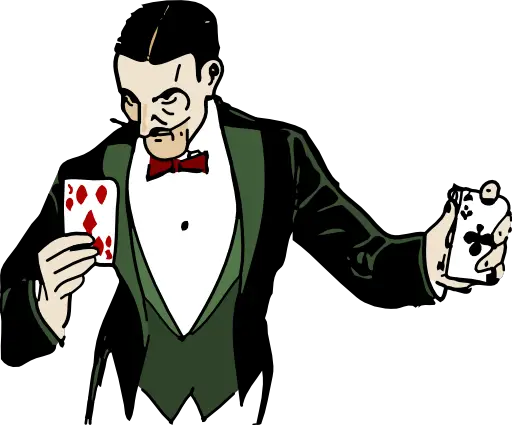Support our educational content for free when you purchase through links on our site. Learn more
🤯 Unmasking the Mind: 7 Secrets of Mentalism Revealed [2024]
Have you ever watched a mentalist on stage and wondered how they do it? Do they actually have psychic powers? The truth is, mentalism is a fascinating blend of psychology, illusion, and showmanship. It’s a world where the impossible seems possible, and the boundaries of reality are constantly challenged. While mentalists may appear to possess supernatural abilities, their skills are rooted in a deep understanding of human behavior, honed observation, and meticulous practice.
In this article, we’ll pull back the curtain and unveil the secrets behind mentalism. We’ll explore the techniques used by these masters of the mind, from cold reading and forcing to hypnosis and sleight of hand. We’ll also delve into the captivating performances that make mentalism so engaging, and discuss the ethical considerations surrounding this unique form of entertainment. Get ready to be amazed, and perhaps a little bit skeptical, as we delve into the world of mind-bending illusions.
Quick Tips and Facts #quick-tips-and-facts
- Mentalism is not real mind reading. 🧠❌ Mentalists are skilled performers who use psychology, suggestion, misdirection, and other techniques to create the illusion of mind reading. Learn more about the techniques of Mentalism
- Anyone can learn mentalism. 🤩 Like any skill, it takes practice and dedication, but with the right guidance, you too can amaze your friends and family. Check out our resources on Magic Psychology to get started.
- Mentalism is all about entertainment. 🎉 It’s a form of entertainment that relies on deception, but it’s meant to be fun and engaging for everyone involved.
- Always be respectful of your audience. 🙏 Never use mentalism to exploit or manipulate others.
Table of Contents
- Quick Tips and Facts
- The History of Mind Reading: From Ancient Oracles to Modern Mentalists
- Unveiling the Secrets: The Techniques Behind Mentalism
- The Art of the Performance: How Mentalists Captivate Their Audience
- Mentalism vs. Magic: What’s the Difference?
- Famous Mentalists: The Masters of Mind Games
- The Ethics of Mentalism: A Balancing Act of Deception and Entertainment
- Conclusion
- Recommended Links
- FAQ
- Reference Links
The History of Mind Reading: From Ancient Oracles to Modern Mentalists #the-history-of-mind-reading-from-ancient-oracles-to-modern-mentalists
The desire to know what others are thinking is as old as time itself. From ancient oracles whispering cryptic prophecies to modern-day mentalists seemingly plucking thoughts from thin air, the allure of mind reading has captivated humanity for centuries.
Ancient Roots and Mysticism
The earliest forms of “mind reading” were often intertwined with religion and mysticism. Oracles in ancient Greece, for example, were believed to be conduits to the gods, delivering divine messages and predictions. These pronouncements, often shrouded in ambiguity, left ample room for interpretation, further fueling their mystique.
The Rise of Stage Mentalism
The late 19th and early 20th centuries saw the emergence of stage mentalism as a form of popular entertainment. Performers like William B. Dunninger, often billed as “The Amazing Dunninger,” captivated audiences with feats of telepathy and mind control. Dunninger’s background in card tricks provided a foundation for his mentalism acts, showcasing the interconnectedness of magic and mentalism.
The Legacy of Mentalism
Today, mentalism continues to thrive, with performers like Derren Brown and The Clairvoyants pushing the boundaries of the art form. They blend psychology, suggestion, and illusion to create mind-boggling experiences that leave audiences questioning the nature of reality itself.
Unveiling the Secrets: The Techniques Behind Mentalism #unveiling-the-secrets-the-techniques-behind-mentalism
While mentalists might appear to possess supernatural powers, their abilities are rooted in a deep understanding of human psychology, keen observation skills, and a mastery of deception. Let’s pull back the curtain and explore some of the most common techniques employed by these masters of the mind:
Cold Reading: The Art of Guessing and Observation #cold-reading-the-art-of-guessing-and-observation
Cold reading is the art of making educated guesses about a person’s life, thoughts, and experiences based on their appearance, body language, and responses. A skilled mentalist can glean a surprising amount of information just by observing someone’s clothing, posture, and subtle cues.
Here’s how it works:
- Generalizations: Mentalists often start with broad statements that apply to most people, like “You’ve experienced a significant loss in your life.”
- Observation: They closely watch for subtle cues like facial expressions, nods, or shifts in posture, which can indicate whether they’re on the right track.
- Refinement: Based on the person’s reactions, the mentalist refines their statements, making them seem more specific and personal.
Example: A mentalist might say, “I sense a connection to a loved one who has passed, someone whose name starts with the letter ‘M’.” While this might seem incredibly specific, it’s actually a common guess, as many people have lost loved ones with names like “Mom,” “Michael,” or “Mary.”
Forcing: Guiding the Audience’s Choices #forcing-guiding-the-audiences-choices
Forcing is a technique where a mentalist subtly influences a participant’s choice, making it seem like a free decision. This can be done through various methods:
- Card forcing: A mentalist might use sleight of hand to ensure a participant selects a specific card from a deck.
- Verbal forcing: By emphasizing certain words or phrases, a mentalist can subtly guide a person towards a particular answer.
- Psychological forcing: Mentalists can exploit psychological biases, like the tendency to choose the middle option, to influence decisions.
Example: A mentalist asks a participant to choose a number between 1 and 10. Through subtle verbal cues and body language, they might unconsciously steer the person towards choosing the number 7.
Hypnosis: Tapping into the Subconscious Mind #hypnosis-tapping-into-the-subconscious-mind
Hypnosis, when used ethically and responsibly, can be a powerful tool in mentalism. By inducing a relaxed, trance-like state, mentalists can bypass the conscious mind and access a person’s subconscious thoughts and memories.
It’s important to note that:
- Hypnosis is not mind control. A hypnotized person is still in control of their actions and cannot be forced to do anything against their will.
- Not everyone is equally susceptible to hypnosis. Some people are more easily hypnotized than others.
Example: A mentalist might hypnotize a participant and suggest that they forget their name. Upon waking, the participant might genuinely struggle to recall their own name, creating a convincing illusion of mind control.
Sleight of Hand: The Art of Deception #sleight-of-hand-the-art-of-deception
Sleight of hand, a cornerstone of magic, also plays a role in mentalism. Mentalists often use subtle hand movements and manipulations to secretly obtain information, switch objects, or create illusions.
Here are some ways mentalists employ sleight of hand:
- Palming: Secretly holding onto an object, like a coin or a piece of paper, while making it appear to have vanished.
- Switching: Seamlessly exchanging one object for another, often without the audience noticing.
- Misdirection: Using distractions and body language to draw the audience’s attention away from the secret actions.
Example: A mentalist might ask a participant to write down a secret thought on a piece of paper. Using sleight of hand, they might switch the paper for a duplicate, allowing them to “reveal” the thought later in the act.
Mentalism and Technology: The Rise of Digital Deception #mentalism-and-technology-the-rise-of-digital-deception
In the digital age, mentalists are incorporating technology into their acts, blurring the lines between reality and illusion even further.
Here are some ways technology is being used in mentalism:
- Social Media Magic: Mentalists can use social media platforms to gather information about their audience, creating the illusion of knowing their personal lives.
- Smartphone Illusions: Apps and smartphone features can be cleverly integrated into mentalism routines, allowing for seemingly impossible feats.
- Virtual Reality and Augmented Reality: These immersive technologies offer new possibilities for creating mind-bending experiences.
Example: A mentalist might ask a participant to think of a childhood memory. Using a combination of social media research and subtle suggestion, the mentalist might be able to reveal details about the memory, making it appear as if they have accessed the person’s thoughts.
The Art of the Performance: How Mentalists Captivate Their Audience #the-art-of-the-performance-how-mentalists-captivate-their-audience
Beyond the technical skills, mentalism is also about showmanship, storytelling, and creating a compelling experience for the audience. Here’s how mentalists transform simple tricks into unforgettable performances:
Stage Presence and Showmanship #stage-presence-and-showmanship
A captivating stage presence is crucial for any mentalist. They need to command attention, establish rapport with the audience, and create an aura of mystery and intrigue.
Key elements of stage presence include:
- Confidence: Mentalists need to project an air of confidence in their abilities, even if they’re secretly nervous.
- Charisma: A charismatic personality can draw the audience in and make them more receptive to the performance.
- Body Language: Confident posture, eye contact, and purposeful movements all contribute to a strong stage presence.
Building Suspense and Tension #building-suspense-and-tension
Mentalists are masters of pacing and timing, knowing how to build suspense and keep the audience on the edge of their seats.
Techniques for building suspense:
- Pauses: Strategic pauses can heighten anticipation and create a sense of drama.
- Music and Sound Effects: Eerie music or sound cues can enhance the atmosphere and create a sense of unease.
- Gradual Reveals: Instead of revealing everything at once, mentalists often unveil information slowly, piece by piece, to keep the audience guessing.
The Power of Storytelling #the-power-of-storytelling
Mentalists often weave their tricks into compelling narratives, transforming simple illusions into unforgettable experiences. Stories can make the impossible seem more believable and create an emotional connection with the audience.
Effective storytelling techniques:
- Personal Anecdotes: Sharing personal stories can make the mentalist seem more relatable and their abilities more genuine.
- Themes of Mystery and Intrigue: Stories that tap into our fascination with the unknown can make the mentalism act even more engaging.
- Audience Participation: Involving the audience in the story can create a sense of shared experience and wonder.
Mentalism vs. Magic: What’s the Difference? #mentalism-vs-magic-whats-the-difference
While mentalism and magic are often grouped together, there are some key distinctions between these two forms of entertainment.
Mentalism:
- Focus: The mind and its perceived abilities, such as telepathy, clairvoyance, and mind control.
- Presentation: Often presented as a demonstration of “real” psychic powers, though many mentalists are transparent about their use of trickery.
- Goal: To create a sense of wonder and astonishment, leaving the audience questioning the limits of the human mind.
Magic:
- Focus: Illusions, sleight of hand, and defying the laws of physics.
- Presentation: Typically presented as a form of entertainment, with the magician acknowledging the use of tricks and illusions.
- Goal: To entertain and amaze the audience with visually spectacular and seemingly impossible feats.
Overlapping Territories:
It’s important to note that the line between mentalism and magic can be blurry. Some performers blend elements of both, creating hybrid acts that blur the lines between mind reading and illusion.
Famous Mentalists: The Masters of Mind Games #famous-mentalists-the-masters-of-mind-games
Throughout history, numerous mentalists have captivated audiences with their seemingly impossible feats. Here are a few of the most renowned figures in the world of mentalism:
-
Derren Brown: A British mentalist known for his elaborate stunts, psychological illusions, and captivating stage presence. Brown is a master of suggestion and misdirection, often leaving audiences questioning the nature of reality itself.
-
The Amazing Kreskin: A prolific mentalist with a career spanning decades, Kreskin is renowned for his ability to seemingly read minds and predict future events. He’s also famous for his $100,000 challenge, offering the reward to anyone who could prove he uses supernatural powers.
-
Uri Geller: An Israeli-British illusionist who gained international fame in the 1970s for his trademark spoon-bending act. While Geller claims to possess psychic abilities, his performances have been met with both skepticism and fascination.
-
Joseph Dunninger: Often hailed as one of the greatest mentalists of all time, Dunninger was a master of cold reading, suggestion, and audience management. He was known for his radio show, where he would seemingly answer questions from listeners’ minds.
-
The Clairvoyants: This Austrian duo, consisting of Thomée Ten Bosch and Amélie van Tass, rose to prominence on “America’s Got Talent” with their stunning displays of telepathy and mind reading. Their performances are a testament to the power of nonverbal communication and the art of creating the illusion of a psychic connection.
The Ethics of Mentalism: A Balancing Act of Deception and Entertainment #the-ethics-of-mentalism-a-balancing-act-of-deception-and-entertainment
Mentalism, like any form of entertainment involving deception, raises ethical questions. Here are some key considerations:
- Transparency vs. Illusion: Should mentalists be upfront about their use of trickery, or is maintaining the illusion of psychic abilities acceptable as long as it’s for entertainment purposes?
- Exploitation and Manipulation: Mentalists should never use their skills to exploit or manipulate vulnerable individuals.
- Respect for Beliefs: It’s important to be mindful of people’s beliefs and avoid using mentalism to mock or belittle those who hold spiritual or paranormal views.
Ultimately, the ethics of mentalism come down to responsible practice. Mentalists should strive to entertain and amaze without resorting to harmful or exploitative behavior.
Conclusion #conclusion
Mentalism is a fascinating blend of psychology, illusion, and showmanship. It’s a world where the impossible seems possible, and the boundaries of reality are constantly challenged. While mentalists may appear to possess supernatural abilities, their skills are rooted in a deep understanding of human behavior, honed observation, and meticulous practice.
So, the next time you witness a mind-bending mentalism performance, remember that it’s a carefully crafted illusion, a testament to the power of human creativity and the art of deception. But don’t let that diminish the wonder and amazement that these performances inspire. The magic of mentalism lies in its ability to captivate our imaginations and leave us questioning the limits of our own minds.
Recommended Links #recommended-links
👉 Shop Mentalism Products on:
- Derren Brown: Amazon | Walmart | Derren Brown Official Website
- The Amazing Kreskin: Amazon | Walmart | The Amazing Kreskin Official Website
- Uri Geller: Amazon | Walmart | Uri Geller Official Website
- Joseph Dunninger: Amazon | Walmart
- The Clairvoyants: Amazon | Walmart
Explore Mentalism Through Books:
- “The Mind of Derren Brown” by Derren Brown: Amazon
- “The Amazing Kreskin: My Story” by The Amazing Kreskin: Amazon
- “The Geller Effect” by Uri Geller: Amazon
- “The Art of Mentalism” by Tony Corinda: Amazon
- “The Mentalism Handbook” by Richard Osterlind: Amazon
FAQ #faq
How do mentalists know what you’re thinking? #how-do-mentalists-know-what-youre-thinking
Mentalists don’t actually read your mind. They use a variety of techniques to create the illusion of mind reading. These techniques include:
- Cold reading: Making educated guesses about a person based on their appearance, body language, and responses.
- Forcing: Subtly influencing a participant’s choice, making it seem like a free decision.
- Hypnosis: Inducing a relaxed state to access a person’s subconscious thoughts and memories.
- Sleight of hand: Secretly obtaining information, switching objects, or creating illusions.
- Technology: Using apps, social media, and other digital tools to gather information about their audience.
How do mentalists guess words? #how-do-mentalists-guess-words
Mentalists often use a combination of techniques to guess words, including:
- Forced choices: Mentalists might subtly force a participant to choose a specific word, making it seem like a random selection.
- Word association: Mentalists might use words or phrases that trigger common associations, making it seem like they’re tapping into the participant’s mind.
- Pre-show research: Mentalists might gather information about their audience beforehand, using this knowledge to guess words they’re likely to think of.
How to do mentalism? #how-to-do-mentalism
Learning mentalism is a journey that requires dedication and practice. Here’s a roadmap:
- Master the Basics: Start by learning the fundamental techniques of mentalism, such as cold reading, forcing, and misdirection.
- Develop Your Observation Skills: Pay close attention to people’s behavior, body language, and verbal cues.
- Study Psychology: Gain an understanding of human behavior, motivations, and biases.
- Practice Regularly: The more you practice, the more confident and skilled you’ll become.
- Find a Mentor: Consider seeking guidance from experienced mentalists or magicians.
- Develop Your Own Style: Experiment with different techniques and create unique routines that showcase your personality and talents.
How do mentalists do the envelope trick? #how-do-mentalists-do-the-envelope-trick
The envelope trick, where a mentalist seemingly predicts a participant’s choice written on a piece of paper, is a classic mentalism illusion. Here’s a common method:
- The Setup: The mentalist provides an envelope to a participant, asking them to write down a word or phrase and seal it inside.
- The Switch: Using sleight of hand, the mentalist secretly switches the envelope for a duplicate, which already contains the “predicted” word or phrase.
- The Reveal: The mentalist then opens the envelope and “reveals” the participant’s chosen word, creating the illusion of a mind-reading prediction.
Reference Links #reference-links
- Wikipedia: A comprehensive overview of mentalism, its history, techniques, and notable figures.
- Derren Brown Official Website: Learn more about the work of Derren Brown, one of the most influential mentalists of our time.
- The Amazing Kreskin Official Website: Discover the legacy of The Amazing Kreskin, a mentalist who has captivated audiences for decades.
- Uri Geller Official Website: Explore the world of Uri Geller, known for his spoon-bending and other feats of psychic ability.
- Fergus Flanagan: Learn about the techniques used by mentalists and how they create the illusion of mind-reading.
- James Randi Educational Foundation: A non-profit organization dedicated to promoting scientific skepticism and debunking claims of paranormal phenomena.







